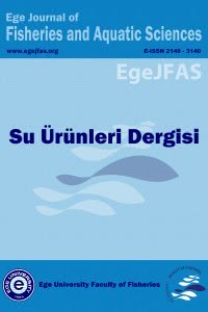Pond culture of penaeus semisulcatus (De Haan,1844) in sub-tropical conditions of Türkiye
Türkiye, Penaeus semisulcatus, çevresel faktörler, büyüme, gölet, balık beslenmesi, uyum, sucul kültür, yem çevirimi
Penaeus semisulcatus (De Haan,1844)'un Türkiye'nin yarı-tropik iklim koşullarında havuzda yetiştiricilliği
Turkey, Penaeus semisulcatus, environmental factors, growth, ponds, fish feeding, adaptation, aquaculture, feed conversion,
___
Aktaş, M., Kumlu, M. 1999. Gonadal Maturation and Spawning of Penaeus semisulcatus (Penaeidae: Decapoda). Turk J. Biol. 23, 61-66.Browdy, C.L., Samocha, T.M. 1985a. The Effects of Eyestalk Ablation on Spawning, Molting, and Mating of Penaeus semisulcatus de Haan. Aquaculture, 49, 19-29.
Browdy, C.L., Samocha, T.M. 1985b. Maturation and Spawning of Ablated and Non-ablated Penaeus semisulcatus de Haan, 1884. J. World Aquacult. Soc. 16, 236-249.
Issar, G., Seidman, E.R., Samocha, Z. 1987. Preliminary Results of Nursery and Pond Culture of Penaeus semisulcatus in Israel. Bamidgeh, 39(3), 63-74.
Kumlu, M., Başusta, N., Avşar, D., Eroldoğan, O.T. 1999a. Some Biological Aspects of Penaeid Shrimps in Yumurtalık Bight of North-eastern Mediterranean. Turk. J. Zool. 23, 53-59.
Kumlu, M., Eroldoğan, O.T., Aktaş, M. 1999b. The Effects of Salinity on Larval Growth, Survival and Development of Penaeus semisulcatus (Decapoda: Penaeidae). Bamidgeh,51(3), 114-121.
Kumlu, M., Eroldoğan, O.T., Aktaş, M. 2000a. Effects of Temperature and Salinity on Larval Growth, Survival and Development of Penaeus semisulcatus. Aquaculture, 188(1/2): 167-173.
Kumlu, M., Eroldoğan, O.T. 2000b. Effects of Temperature and Substrate on Growth and Durvival of Penaeus semisulcatus Postlarvae. Turk. J. Zool. 24, 337-341.
Seidman, E.R., Issar, G.1988. The Culture of Penaeus semisulcatus in Israel. J. World. Aquacult. Soc. 19(4), 237-245.
Samocha, T.M., Lawrence, A.L., Biedenbach, J.M. 1990. A New Concept for Water Management Strategy for Nursery of Penaeids Postlarvae in Raceways. Abstracts, World Aquaculture 90, 1990, Halifax, Canada.
Sturmer, L.N., Lawrence, A.L. 1988. Feeding Regimes for Enhanced Penaeus vannamei Production in Intensive Nursery Raceways. J. World Aquacul. Soc; 19: 68A.
Şereflişan, H., Kumlu, M., Tekelioğlu, N. and Şereflişan, M. 1998. The Effects of Different Stocking Densities on the growth of Penaeus semisulcatus (Crustacea: Decapoda). In: B. Papathanassiou (Ed.), Proceedings of the 4th Balkan Conference on Operational Research, Volume II, Hellenic Operational Research Society (Helors), Macedonia-Thrace Branch, pp. 611-616.
Yashouv, A. 1971. On the Possibility of Developing Shrimp Culture in Israel. Daig Umidgeh, 4(2), 24-33.
- ISSN: 1300-1590
- Yayın Aralığı: 4
- Başlangıç: 1984
- Yayıncı: Aynur Lök
LATİF TAŞKAYA, ŞÜKRAN ÇAKLI, UFUK ÇELİK
Barbus capito pectoralis (Heckel,1843)'in büyüme özellikleri ile et veriminin incelenmesi
ERDAL DUMAN, FAHRETTİN YÜKSEL, Murat PALA
Probiyotikler ve su ürünlerinde kullanımı
Ali Yıldırım KORKUT, Belgin HOŞSU, Melike FERHATOĞLU
Karides yetiştiriciliğinde larval kalite
Balık yetiştirme çiftliklerinde ağ kafeslerin tuzak olarak kullanımı üzerine bir ön çalışma
Cenkmen R. BEĞBURS, UĞUR ALTINAĞAÇ
Mehmet Ali Canyurt, SÜLEYMAN AKHAN, ÇİĞDEM TAKMA
UĞUR ÖZEKİNCİ, Cenkmen R. BEĞBURS, Ersin TENEKECİOĞLU
Donmuş karideslerin bazı fiziksel, kimyasal ve mikrobiyolojik özellikleri
